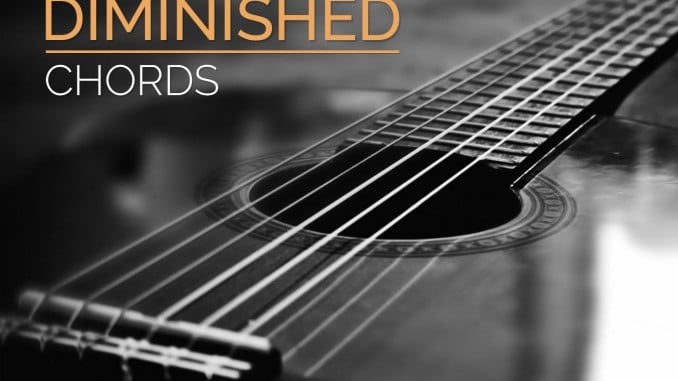
Learn diminished and diminished seventh chord grips, how they’re constructed, and when to use them. You’ll learn how dim7 chords form a fun pattern that can be played in many locations.
Diminished chords have a dissonant sound. There is a lot of tension. It is primarily used in Jazz styles.
Diminished Chord Formula
In major keys, the diminished chord is built off the 7th degree of the major scale.
If you construct a diminished chord from its parallel major scale (ex: C dim from the C major scale), you would use the following pattern.
Diminished Chord Formula: 1-♭3-♭5
If you want a plain diminished chord, all you have to do is remove the VI note, or learn a movable pattern (just like any other chord) as shown below. (R= Root note)
Diminished Patterns
There are a lot of playable diminished patterns. I provided 9 of them. You’ll notice a lot of similarities among them. You’ll see in a moment that the Dim7 patterns are actually easier to use.
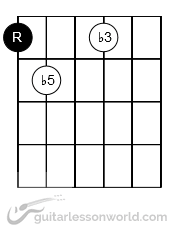
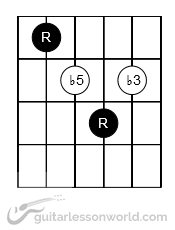
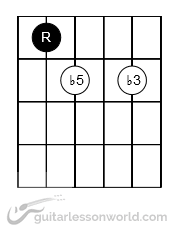
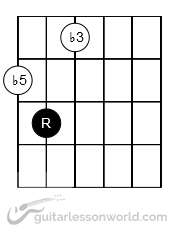
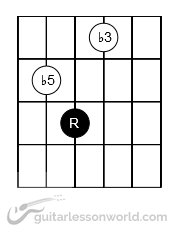
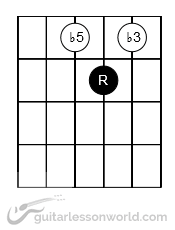
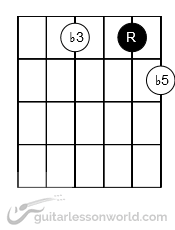
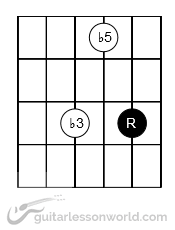
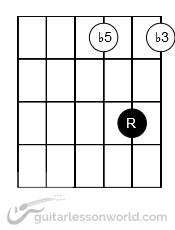
Diminished Seventh Chord Formula
The diminished 7th chord adds a double-flatted 7th to the diminished chord to form the following pattern.
Diminished 7th Chord Formula: 1-♭3-♭5-♭♭7
Cdim7 = C-E♭-G♭-B♭♭
You will notice that a ♭♭7 is the same pitch as the 6. In other words, B♭♭ is enharmonic with A. The use of a double flat ensures we are communicating the notes properly.
For practical purposes, you can use the chord formula: 1-♭3-♭5-6.
Diminished Intervals
Diminished chords are constructed of minor third intervals.
- C to E♭ is a minor third
- E♭ to G♭ is a minor third
- G♭ to B♭♭ (or A) is a minor third
- B♭♭ (A) to C is a minor third
Any of the four notes (for dim7 chords) can be the root note. Perhaps that is why it sounds so dissonant. It also means the next pattern is only a minor third (3 frets away).
Drop-2 Diminished 7th Patterns
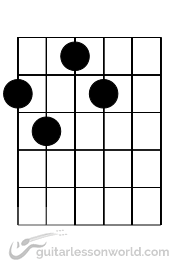
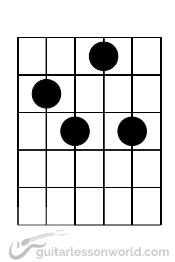
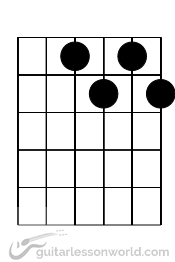
Diminished 7 Chord Shift
You’ll notice in the two examples below that you can move the dim7 pattern up 3 frets to find another dim7 chord with the same exact notes. It is simply a different voicing. In other words, you have 4 voicings per grip! This is incredibly useful.
Shift Example 1
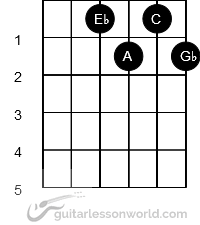
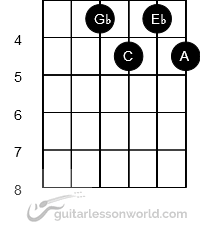
Shift Example 2
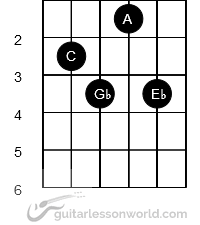
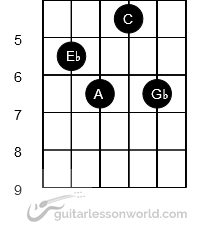
How the Diminished 7 Chord is Used
Diminished chords are not used very often. They can be used in a major key, but this is not common. If they are, it is based on the 7th degree of the scale. In the key of C, this would be Bdim. Diminished chord theory is a topic worthy of its own lesson (or course), but I will try to explain one of the primary uses in Jazz, which is as a chord substitution.
Diminished 7 chords are used as chord substitutions for Dominant7♭9 chords. Actually, diminished 7 chords substitute for four different 7♭9 chords.
Why the Substitution Works
Let’s look at the 7♭9 chord formula: 1-3-5-♭7-♭9
Notice this pattern:
- 3rd to 5th is a minor third.
- 5th to ♭7 is a minor third.
- ♭7 to ♭9 is a minor third.
Those are the same intervals as the dim7 chord. If you add a root note, which is usually played by a bass player, you have a 7♭9 chord. Consider that we know the diminished 7 chord voicings are interchangable. This means that you can find a root note by going down a major third from any note.
Cdim7 has the following notes C-E♭-G♭-A
- A♭ is a major third (2 steps) down from C, therefore we can substitute for A♭7♭9
- B is a major third down from E♭, therefore you can substitute for B7♭9
- D is a major third down from G♭, therefore you can substitute for D7♭9
- F is a major third down from A, therefore you can substitute for F7♭9
We’re figuring this out backwards. The easiest way to learn this substitution is to take the root note of the 7♭9 chord, raise it by a semitone (1/2 step) and play that diminished chord. It works every time due to the symmetry of the dim7 chord.
- A♭7♭9 would use the Adim7 chord substitution.
- B7♭9 would use the Cdim7 chord substitution.
- D7♭9 would use the E♭dim7 chord substitution.
- F7♭9 would use the G♭dim7 chord substitution.
Of course, we know that Adim7, Cdim7, E♭dim7, and G♭dim7 use the same notes, so they’re completely interchangable.
When are 7♭9 Chords Used?
They are primarily used in diminished harmonies, which is a lesson or course in itself, but you may be able to incorporate them into your playing.
Since these are dominant chords, they want to resolve down a perfect fifth or up a perfect fourth. So you can resolve these down to one of four different chords.
- A♭7♭9 resolves to D♭maj7
- B7♭9 resolves to Emaj7
- D7♭9 resolves to Gmaj7
- F7♭9 resolves to B♭maj7
You will notice that they resolve 1/2 step up from any of the diminished chord notes.
- D♭maj7 is a semitone higher than C
- Emaj7 is a semitone higher than E♭
- Gmaj7 is a semitone higher than G♭
- B♭maj7 is a semitone higher than A
What this means it that you can literally change keys when one of these chords shows up. We just learned that Cdim7, E♭dim7, G♭dim7, and Adim7 are enharmonically the same chord and that they resolve to four different major chords: D♭, E, G, and B♭. In other words, you can substitute a dim7 for your V7 chord if you’re willing to put up with one out-of-key note. It will give a diminished that that works well.
Example of Changing Keys with Diminished Chords
Let’s assume we’re in the key of E. Our Cdim7, E♭dim7, G♭dim7, and Adim7 (which is the same chord) resolves to E. One of these four, E♭ is only a 1/2 step down, which is enharmonic with the 7th of E, D♯. This is an easy way to remember it. You can also play the ii-dim7 or the iv-dim7, which are also in our set of four.
The following example is a simple ii-V-I with the vii-dim7 substituted for the V chord.
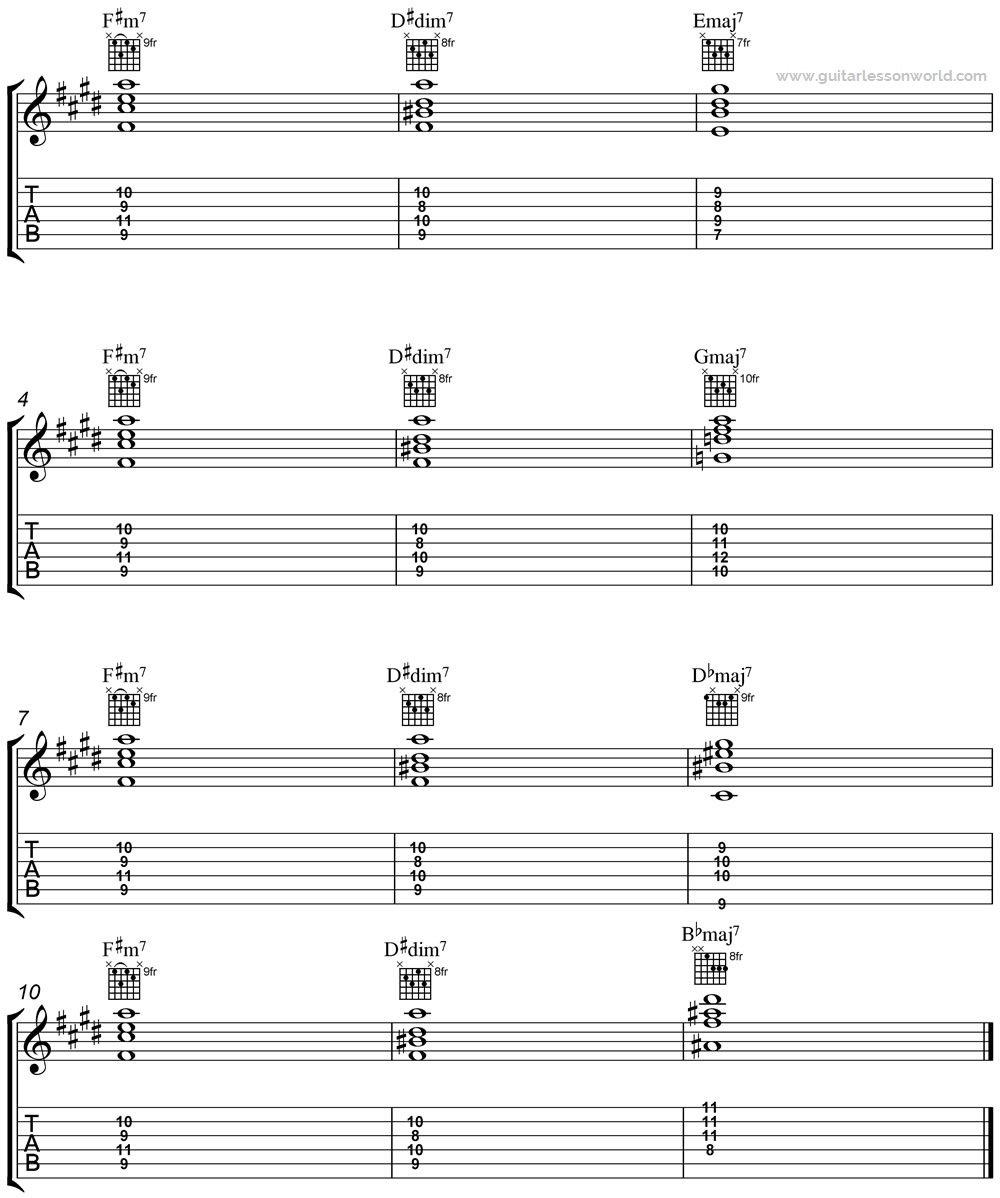
Conclusion
Diminished chords are fun because of their symmetry. They are also flat-out dissonant, but they can resolve nicely if you use them well. The fact that you can change keys (as shown) is a fun nuance. Enjoy!
If you liked this lesson, do me a favor and like my facebook page so you can find out when I make updates or fun announcements.


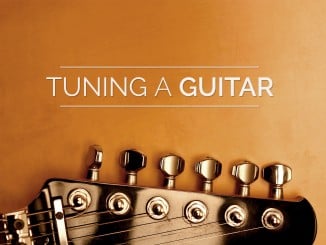
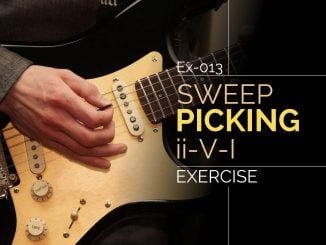

Very helpful. I’m just getting into both diminished and 7th chords and was having to look them continuously in my ‘book of chords’. This will make it much easier. Especially, understanding the 6th note relationship.
Thank You
Thank you for the kind words! I just updated this lesson yesterday, so I’m glad you liked it. More updates are coming soon!
I just signed up.I read your lesson on dim chords and it was quite informative. I don’t quite understand it all, but after another read through (or two, three) I’ll get it. Very well written. I look forward to more!!;
I’m glad you liked the article! Feel free to email me your questions through my contact page. I’ll do my best to clarify and it’ll help me ensure the article is easily understood for other readers.
awesome lesson. i think dim chords are perfect if resolve them correctly.
greetings
I must say, I am quite impressed. Awaiting your comment.
Still doesn’t help me understand the difference between C7b9, C7+9, and Cdim – they are all diminished chords, but I’ve been searching for months for a decent explanation of the difference – but not one single explanation has yet been forthcoming. Maybe that’s why Jazz is so hard – it seems like a closely guarded secret.
Diminished chords are confusing to most. I’ll try to make it clearer. If you omit the C from C7b9 (C Db E G Bb), you have a dim7 chord. Since the bass player usually plays the root, you don’t need to worry about that note. C7+9 is a C7 chord with an augmented 9th (C D# E G Bb). It contains Edim but not a dim7 chord. Cdim is simply C Eb Gb. To go into greater depth, I’d need to know the context.
I hope this helps!
Thank you so much! Very helpful!
You’re welcome!
Hi Patrick I’m a newby my name is tony could do something on augmented chords or the theroy on them thanks I’m hooked go head and reel me in thanks sir
Classic G dim, is played by ZZ Top. Billy Gibbons calls it G demolished.
What amazing secret I’ve just completely discovered concerning the 5dim and 7dim chords! A few hours ago they were just useless to me as an ambitious guitarist but now my confidence is suddenly build up by your simple yet very understandable explanation
I am glad you enjoyed the lesson! Have fun with diminished chords!
You are really a great guitarist and a great teacher!!
I really appreciate your work!
THANK YOU!!!
Thank you for the kind words. I’m glad I could help.